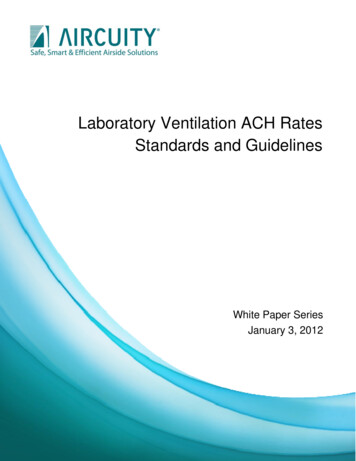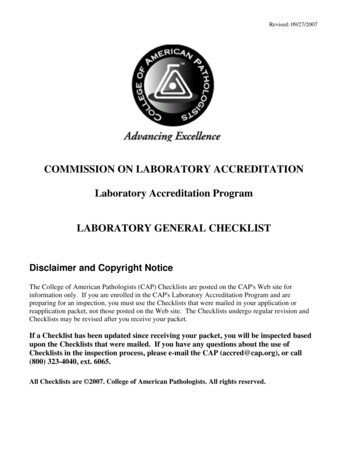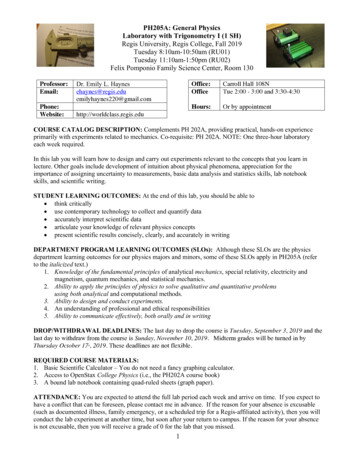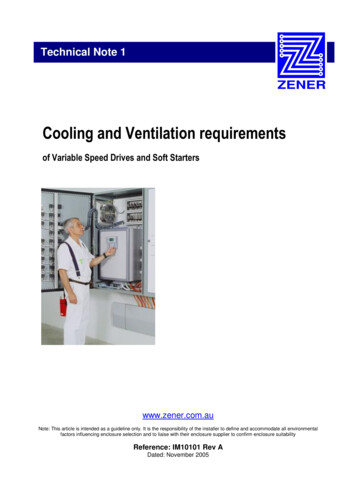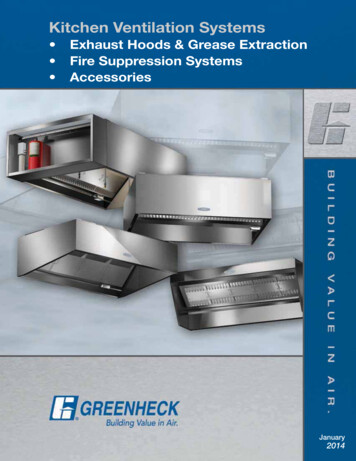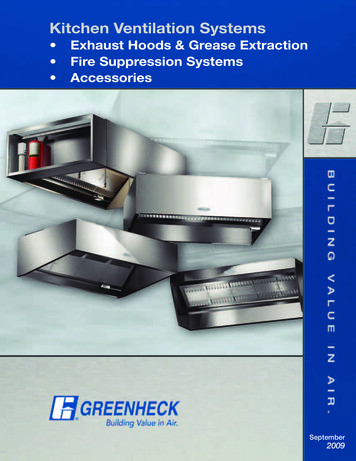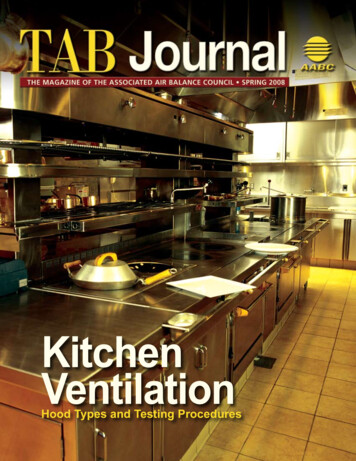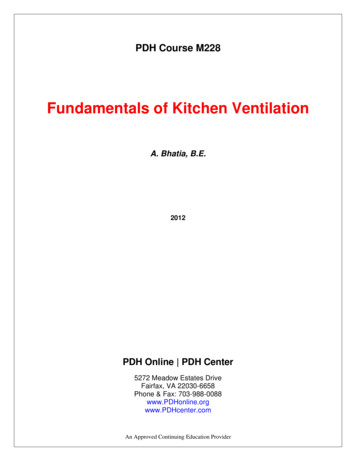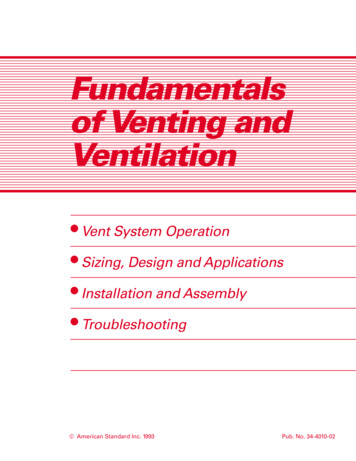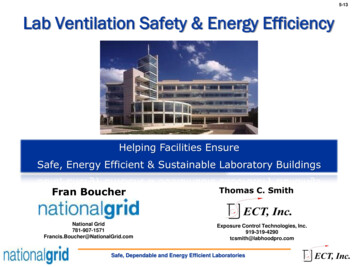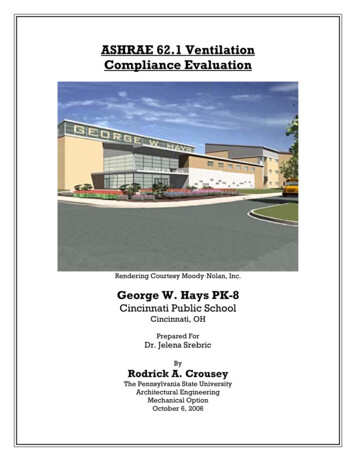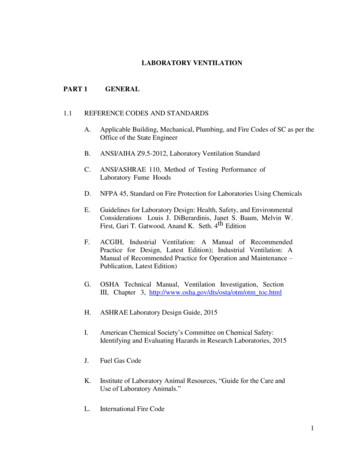
Transcription
LABORATORY VENTILATIONPART 11.1GENERALREFERENCE CODES AND STANDARDSA.Applicable Building, Mechanical, Plumbing, and Fire Codes of SC as per theOffice of the State EngineerB.ANSI/AIHA Z9.5-2012, Laboratory Ventilation StandardC.ANSI/ASHRAE 110, Method of Testing Performance ofLaboratory Fume HoodsD.NFPA 45, Standard on Fire Protection for Laboratories Using ChemicalsE.Guidelines for Laboratory Design: Health, Safety, and EnvironmentalConsiderations Louis J. DiBerardinis, Janet S. Baum, Melvin W.First, Gari T. Gatwood, Anand K. Seth. 4th EditionF.ACGIH, Industrial Ventilation: A Manual of RecommendedPractice for Design, Latest Edition); Industrial Ventilation: AManual of Recommended Practice for Operation and Maintenance –Publication, Latest Edition)G.OSHA Technical Manual, Ventilation Investigation, SectionIII, Chapter 3, http://www.osha.gov/dts/osta/otm/otm toc.htmlH.ASHRAE Laboratory Design Guide, 2015I.American Chemical Society’s Committee on Chemical Safety:Identifying and Evaluating Hazards in Research Laboratories, 2015J.Fuel Gas CodeK.Institute of Laboratory Animal Resources, “Guide for the Care andUse of Laboratory Animals.”L.International Fire Code1
1.21.3SCOPEA.This Standard defines Clemson’s expectations for the design oflaboratory spaces, including space layout and the design ofventilation systems. Such designs shall strive to balance thesustainability goals of the University while maintaining the safetyand health of laboratory occupants and the general public. It issuggested that Designers review additional laboratory ventilationinformation located at the Research Safety web sitewww.clemson/research/safety.edu for further guidance.B.This Standard applies to construction of new facilities andrenovations to existing facilities in which chemical work is to bedone at laboratory-scale. Facilities in which chemical work isconducted beyond lab-scale, or for which other hazards, such ashigh chemical hazard, radiological or biological hazards are thedesign drivers may require specialty design criteria. Designers shallconsult with Facilities Services and Research Safety beforeproceeding to determine a basis for design in order to address thespecial considerations for these types of spaces.DEFINITIONSA.For the purposes of this Standard, “Laboratory” refers to a space orfacility where relatively small quantities of hazardous chemicals (i.e.amounts that can be safely handled by one person) are used on a nonproduction basis.B.“General exhaust ventilation”, also called dilution ventilation,differs from local exhaust ventilation in that in lieu of capturingemissions at their source and removing them from the air, generalexhaust ventilation allows the contaminant to be emitted into theworkplace air where it is diluted at an acceptable level (e.g., to thePermissible Exposure Level or below).C.“Local exhaust ventilation” systems are composed of five parts:fans, hoods, ducts, air cleaners, and stacks. Local exhaustventilation is designed to capture an emitted contaminant at or nearits source, before the contaminant has a chance to disperse intothe workplace air.D.“Computational Fluid Dynamics” is the use of numerical methodsto calculate and visualize air flow patterns or particulate migration.E.A “Vacant” laboratory is one that is unassigned to an occupantand therefore can have the general ventilation and fume hoods2
turned off or turned down to levels needed only for generaltemperature control.F.“Occupied” mode is that which the building controls systemsensors recognize that a person is physically within the room.G.“Unoccupied” mode is that which the building controls systemsensors recognize that there is no one present in the room.H.Fume hood “Hibernation” describes when the lab is assigned to anoccupant, but the operation of the fume hood is not required,and the fume hood exhaust can be temporarily shut down.I.Air Changes per Hour (ACH): A common means for expressing avolumetric airflow through a room. Each ACH for a room isintended to represent an amount of air equal to the gross volume ofair passing through the room each hour. An ACH rate for a room canbe converted to volumetric airflow by multiplying the ACH numbertimes the gross volume in the room. The air change rate depends onthe exhaust flow for a negatively pressurized room and on supplyflow for a positively pressurized room. The term does not reflectactual mixing factors and therefore does not indicate the effective airexchange rate in the room.J.Constant Air Volume (CAV) Ventilation system: A ventilationsystem designed to maintain a constant quantity of airflow within itsductwork. The airflow quantity is typically based upon heating orcooling load, make-up air requirements, or minimum air changerequirements. Although relatively simple, a constant volume systemtypically requires the maximum ongoing energy usage.K.Discharge Velocity: The speed of the exhaust air normallyexpressed in feet per minute (meters/second) of the point ofdischarge from a laboratory exhaust system. Since laboratoryexhaust fans may be configured to discharge into a vertical exhauststack or may utilize fans specifically designed to discharge directlyupward, the discharge velocity normally refers to the air velocity asit leaves the last element of the exhaust system. Since the top of anexhaust stack may be conical (or other type of configuration), thevelocity of the exhaust air at the point of discharge may differ fromthe velocity of the air within the vertical stack. The term “stackvelocity” is sometimes used when referring to the speed of theexhaust airstream as it is discharged into the outside air.L.Face Velocity: The air velocity of the plane of and perpendicular tothe opening of a laboratory chemical hood.3
1.1M.HEPA: High Efficiency Particulate Air (filter) for air filters of99.97% or higher collection efficiency for 0.3 micrometers diameterdroplets of an approved test aerosol operating at a rated airflow.N.Variable Air Volume (VAV) Ventilation System:HVAC system specifically designed to vary theconditioned air supplied and exhausted from the spacesamount of air supplied and intended to meet (but notactual need of a space at any point in time.A type ofamount ofserved. Theexceed) theSUMMARY COMMENTS:A.General room ventilation shall be provided to prevent the buildup offugitive emissions in the laboratory. A general room ventilationsystem shall be designed to maximize the r e m o v a l ofcontaminants from the room while minimizing overall energy use.Demonstrating ventilation effectiveness through design tooptimize laboratory room air mixing and dilution is moreimportant than delivering a bulk quantity of ventilation (airchange per hour ACH). Each lab should be designed to meetrequired fume hood velocity, directional airflow within thelaboratory and an established air change rate. In laboratorieswhere the heat load exceeds the required ventilation ratesupplemental local recirculating systems such as fan coil unitsshould be considered.B.The P r o j e c t Engineer shall provide a “Basis of Design”statement for all lab designs that clearly defines all systemcriteria and assumptions made during the project design process.Documentation shall include, but not be limited to, design andoperational criteria such as, laboratory air change rates, anticipatedchemical usage, description of the lab ventilation control system,equipment heat loading, anticipated occupancy, and diversities aswell as references to codes and standards used. Clemson shallprovide the Owner’s Project Requirements upon which the Basis ofDesign is developed.C.CFD Modeling should be considered to verify ventilationeffectiveness on all new buildings and major renovations. Thediscussion/development will be defined in the Owner’s ProjectRequirements.D.The mechanical system selection, including heat recovery systems,shall be supported by a life cycle cost analysis of the options. Thedesigner shall submit an economic analysis during schematicdesign. Heat wheels are not permitted in chemical hood exhaust, but4
may be in general exhaust if approved by Research Safety. Heatwheels are not permitted in animal facilities.1.21.3E.Prior to the design of new laboratory facilities, Research Safety willprovide a chemical usage questionnaire to be completed by the usersor other appropriate University personnel having knowledge of thechemicals or types of chemicals to be used. The completed form willbe reviewed by Research Safety, Users, the Design Consultant, etc.after completion.F.All hazard control ventilation system plans/blueprints/change ordersmust be reviewed by Research Safety.No chemical hood or other laboratory ventilation device may beinstalled without the approval of RS. Ventilation devices should notbe purchased until a Facilities permit to install them has beenapproved.ANIMAL ROOMS:A.If the project includes housing for animals, the consultant shallcontact Godley-Snell Research Services and the universityIACUC for information on animal facilities and housing.B.Recirculation of exhaust air is prohibited. Directional air flow isrecommended. Recommend compliance with the Institute ofLaboratory Animal Resources, “Guide for the Care and Use ofLaboratory Animals.”C.A hand washing sink shall be provided within each animal room.LABORATORY EXHAUST SYSTEM ANALYSIS:A.All laboratory exhaust systems must comply with the S out hC arol i na Building Codes, ANSI/AIHA Z9.5 and Sheet Metal andAir Conditioning Contractors National Association (SMACNA)standards1.Effluent discharge shall be a minimum of ten feet above theroof surface with a velocity of 3,000 feet per minute (fpm)velocity unless it can be demonstrated that a specific designmeets the dilution criteria necessary to reduce theconcentration of hazardous materials in the exhaust to safelevels at all potential receptors (ANSI /AIHA Z9.5).5
2.1.4Exhaust System Classification: The consultant shall berequired to perform an analysis to classify the exhaustsystem when the use of flammable vapors, gases, fumes,mists or dusts, and volatile or airborne materials posing ahealth hazard, such as toxic or corrosive materials areexpected. Classification shall be made in accordance with theInternational Fire Code Mechanical Code Section 510concerning Hazardous Exhaust Systems.LABORATORY DESIGN CRITERIA:A.Ventilation Rates: A prescriptive air exchange rate (air changes perhour) cannot be specified that will meet all conditions in alaboratory. The Table below identifies default ventilation ratesutilizing generic Control Banding principles for common chemicaluse laboratory operations.Research Safety shall provide arecommendation for the ventilation rate.Higher ventilation rates may be required, and less may be acceptable,when the laboratory process is well defined. The designer mustdemonstrate that the proposed ventilation rate will control roomair contaminant concentrations below the current threshold limitvalues (TLV-TWA) established by the American Conference ofGovernmental Industrial Hygienists (ACGIH).Laboratory Ventilation Control Banding:“Control Banding” is a system for assigning generic protectionstrategies to similar hazards based on a risk assessment of specificinstances of those hazards; the hazards are grouped into “bands” thatcan be managed by the same suite of controls. The control bandingstrategy was developed by industrial hygienists to identify controlmethods to deal with situations in which hazard information islimited, or the hazards of concern change regularly.In the chemical laboratory setting, general dilution ventilation oflaboratories, beyond that recommended by the ASHRAE 62-2001, isa core engineering control of occupant chemical exposures duringnormal operations. For this reason, specification of generalventilation rates in laboratories should be based on a risk assessmentof the hazards associated with the use of volatile chemicals in thelaboratory.In order to assure the operational, financial and environmentalflexibility and sustainability of laboratory operations, these6
ventilation rates should be minimized as much as possible. Overventilation of laboratory spaces can interfere with the use of thelaboratory for specific operations; can make the detection anddiagnosis of operational and ventilation problems in the laboratorymore difficult; and increases the carbon impacts and dollar costs ofoperating the laboratory facility.Balancing these factors in an ongoing way that is accessible to avariety of stakeholders is the key goal of the Laboratory VentilationStandard developed by the American Industrial Hygiene Association(ANSI Z9.5-2012).This standard requires a procedure forcharacterizing hazardous processes in the laboratory.The optimization process consists of review of laboratory chemicaluses to determine whether they require high, medium, or specializedgeneral ventilation. Research Safety shall determine the ventilationcategory.High ventilation:Laboratories in which there are significant volatile chemical orspecific process hazards for which employee exposures are expectedto be controlled by the general ventilation system are designated forventilation at 8 air changes per hour when the laboratories areoccupied and 4 air changes per hour (ach) when the labs areunoccupied.This recommendation relies on the expectation that significantpoint sources of volatile chemicals are contained by effective localexhaust, in the form of a chemical hood, local point exhaust, or anappropriate chemical storage cabinet. For this reason, in these controlbands laboratory workers will be trained in best practices forusing ventilation systems in the laboratory, specifically in theproper use of the specific hood models and control systems providedin their laboratory and the process of deciding which processesshould be located in a hood based on risk criteria.Specific chemical classes that require this level of ventilation arethose used in concentrations and quantities sufficient to creates
B. ANSI/AIHA Z9.5-2012, Laboratory Ventilation Standard C. ANSI/ASHRAE 110, Method of Testing Performance of Laboratory Fume Hoods D. NFPA 45, Standard on Fire Protection for Laboratories Using Chemicals E. Guidelines for Laboratory Design: Health, Safety, and Environmental Considerations Louis J. DiBerardinis, Janet S. Baum, Melvin W. First, Gari T. Gatwood, Anand K. Seth. 4 th Edition F .
